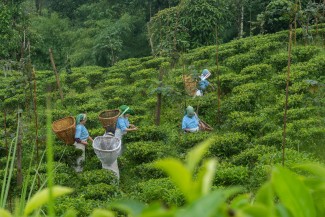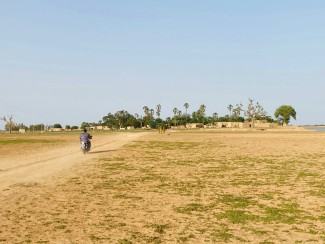Conquering a nut pollutant means lives and livelihoods saved in the process
If you’re at all tapped into coastal trends or certain kinds of celebrity-promoted wellness, then you’re likely familiar with the need to rid your body (and your life) of toxins. What exactly those toxins are remains a mystery, but there are definitely thousands of options around the world for cleansing, purging and purifying.
In The Gambia, on the other hand, they know exactly what toxin they are fighting and why, and one pilot project has begun what is a life-changing battle.
Aflatoxin is produced by a kind of fungus that is found in crops in humid places, and is a danger to humans, animals and plants. If consumed, for example in tainted peanut butter or corn, it is associated with increased risk of liver cancer, and in children stunted growth and delayed development.
With people in The Gambia dependent largely on crops they grow themselves and with a national economy highly reliant on agriculture exports, ensuring fields and foodstuffs are free of this fungus is of utmost importance.
“The international acceptable levels of aflatoxin allowed in groundnut in the European Union is four parts per billion. For The Gambia, the measure of aflatoxin can reach 20 parts per billion or more, so because of that since 2014 Gambian groundnuts have been unable to access markets in the EU,” said Abdouramane Diallo, from the Policy and Partnerships division at the International Islamic Trade Finance Corporation (ITFC).
This has resulted in US$20 million in losses, Diallo added.
SAFE OCCUPATION
So how to get rid of this fungus that emerges, as fungi do, in places with high moisture levels and improper storage practices, and that is disrupting a country’s economy and the lives of its citizens?
“The International Institute of Tropical Agriculture [IITA] developed Aflasafe to fight aflatoxin… Our goal is to encourage farmers to use it, so we have trained them and are giving a group of them Aflasafe free of charge in this pilot phase,” said Ebrima Njie, Quality Control Manager at the National Food Security Cooperative (NFSC).
Aflasafe is a relative of the fungal strain that causes aflatoxin, and when applied to crops it ‘occupies’ the plants, preventing the toxin from developing.
In phase 1 of this pilot project, supported by ITFC and the Enhanced Integrated Framework (EIF), 6,936 farmers in northern Gambia have been trained in the dangers of aflatoxin, been provided Aflasafe and have applied it to their crops.
The first round of testing on those harvests has measured aflatoxin at between zero and four parts per billion, meaning the nuts are now safe for export to the EU. The next step will be purchasing those harvests directly from the farmers at a premium. Then repeat with more farmers.
“It’s a very pragmatic project. We purchased 100 tons of Aflasafe to eventually be applied on 5,000 hectares of 7,000 farmers with the goal to reduce the level of aflatoxin and increase the income of farmers. When they sell aflatoxin-free harvests to the NFSC they will initially get 15 percent more for their product because it can be exported to the EU market, and the premium can reach 30 percent over the long term,” said Diallo.
He added, “Over the next two years what the pilot project will show us is the extent of the resources needed, how many people we need and the equipment. We will extract the lessons learned from the pilot so that we can scale up to the national level in three years or so.”
The lessons learned include that Aflasafe-treated fields can increase farmer incomes and that awareness has to be paid to potential export revenues. The first phase has also shown that timely groundnut purchases from farmers depends on crucial and necessary mastery in the interdependence of activities between the Government, the NFSC and ITFC.
CLEANSING
With toxin-free groundnuts making their way to the EU, this will also help to create market acceptance and build a new brand for a product that had been considered tainted, Diallo said. And, Gambian groundnuts can then garner higher export prices.
Scaling up nationally means all the country’s groundnut crops will have been treated and are aflatoxin-free, which has implications not only for The Gambia’s exports to the EU, but also for Gambians themselves.
“This work can ease a lot of things apart from addressing international markets. If you know The Gambia then you know there are many kinds of groundnuts and it is very important as everyone uses it in their food,” Njie said.
“We make soup, we make groundnut porridge, we cook it with rice, there is a local couscous with groundnuts, and then you have groundnut cake – it’s part of our daily diet. This is making our food safe.”
So this effort sits at a critical space where public health and trade intersect. More clean groundnuts means more export markets and more income for farmers, as well as health impacts that are impossible to quantify.
“I hope sometime between 2020 and 2022 we might be able to say that we fought and mitigated the consequences of aflatoxin in the country. ITFC is technically a trade finance institution, and trade finance products are a shorter-term instrument. But we are also a trade development institution. The combination of the two offers great potential to achieve concrete developmental objectives in a very short period of time. As a matter of fact, in addition to the grant and international support mobilized for the aflatoxin mitigation program, ITFC provides US$20 million in trade finance every year to the Gambian groundnut industry,” Diallo said.
If you would like to reuse any material published here, please let us know by sending an email to EIF Communications: eifcommunications@wto.org.



